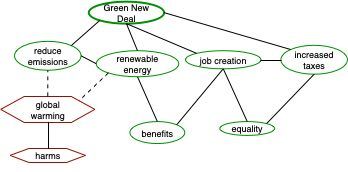Environment
The Moral Psychology of the Green New Deal
What are the ethics of the Green New Deal approach to climate and equality?
Posted December 16, 2019
The Green New Deal is a proposal in the United States, Canada, and other countries to deal simultaneously with climate change and economic inequality. The Green part proposes measures such as drastic reductions in greenhouse gas emissions to prevent further global warming. Otherwise, the planet will face many disasters, such as widespread flooding, according to a strong scientific consensus. The New Deal part proposes measures such as state-sponsored jobs to deal with rapidly increasing inequality, as the rich get richer, and the poor get poorer.
Moral psychology is a field at the intersection of psychology and philosophy that concerns how minds make ethical judgments. It combines the descriptive and explanatory aims of psychology with the normative aims of philosophy, investigating both how people do reach moral conclusions and how they should.
The Green New Deal is an ethical issue with advocates arguing that it is desperately needed to prevent serious harm and to provide clear benefits to hundreds of millions of people. Critics of the Green New Deal see it as a left-wing plot to reduce freedom and destroy economic growth.
Both positions are internally coherent, as I will show by drawing value maps of each position. These maps explain why different people are so convinced of the merits or demerits of the Green New Deal. I then invoke principles from medical ethics to resolve the debate.
Naomi Klein’s new book On Fire concisely makes a strong case for the Green New Deal. She reviews the arguments that global warming is rapidly increasing and threatening the welfare of people in many areas of the world. She advocates economic measures, such as job creation for renewable energy, that deal both with climate change and with economic problems that arise from employment reductions in fossil fuel production. The coherence of this position is shown by the following value map, in which green ovals represent positive values, red hexagons represent negative values, solid lines indicate mutual support, and dotted lines indicate incompatibility.

In contrast, right-wing critics of the Green New Deal see it as using exaggerated concerns about climate to justify draconian economic changes that would produce widespread poverty and loss of freedom. The following value map is based on a Fox News column. Again green ovals represent positive values, red hexagons represent negative values, solid lines indicate mutual support, and dotted lines indicate incompatibility.
In this view, the Green New Deal would generate widespread poverty because of the loss of jobs and reductions in economic growth. It would require high taxes and socialist-style interventions that would dramatically reduce overall freedom.

People have different reactions to these value maps, finding one more emotionally coherent than the other, which explains their different moral reactions to the Green New Deal. The normative side of moral psychology requires asking: Which map is more valid?
Validity is partly an empirical question, resting on such issues as whether global warming is a real problem that humans can deal with by reducing emissions. Almost all scientists agree that it is, and the rejection of the evidence by some politicians is best explained by motivated inference: The oil companies and politicians tied to them do not want to believe that climate change is real, because dealing with it will reduce their money and power.
More difficult are moral issues concerning the priority of different principles. In a previous post on artificial intelligence, I used four principles borrowed from medical ethics:
1. Autonomy: Respect people’s freedom.
2. Beneficence: Provide benefits to people.
3. Nonmaleficence: Avoid harm to people.
4. Justice: Distribute benefits, risks, and costs fairly.
Both advocates and critics of the Green New Deal agree about the importance of providing benefits and avoiding harm, although they have different factual beliefs about what produces benefits and harms. The main normative difference comes in the priority attached to the values of autonomy and justice, with right-wingers caring more about individual freedom, and left-wingers caring more about the fair distribution of benefits and costs.
One way to resolve this conflict is to invoke the distinction made by Isaiah Berlin between two concepts of freedom. Negative liberty is freedom from external control and prescribes minimal state interference, such as taxes. In contrast, positive liberty is the freedom to develop fully as a human being.
Human development is fleshed out in the theory of capabilities, developed by Amartya Sen and Martha Nussbaum, and alternatively in the theory of objective needs, advocated by Thagard 2019 and other philosophers and psychologists. The Green New Deal plausibly can meet human needs both by avoiding the disastrous physical harms that will result from increased climate change (e.g., flooding of many coastal cities) and by increasing equality so that many more people will be able to flourish.
References
Klein, N. (2019). On fire: The burning case for a Green New Deal. Toronto: Knopf Canada.
Thagard, P. (2019). Natural philosophy: From social brains to knowledge, reality, morality, and beauty. New York: Oxford University Press.




